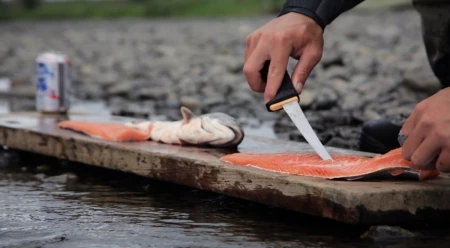The Freedom to Live Off the Land
When I was a kid, the Connecticut River was my Yukon. I spent many days working alongside the river or canoeing its islands and backwaters in search of crabs, snapper, blues, ducks and alewives—amazing silvery fish that brave the depths of the Atlantic to feed and grow and then return to these meandering brooks to spawn in late summer.
I spent long summer days in my grandfather’s small boat in Surry, Maine fishing for mackerel and listening to his stories of cutting holes into the frozen salt water bay to hook returning smelt in the dead of winter. Something visceral and elemental was going on for me.
As it turned out, those days that shaped the rest of my life were the last taste of abundance on the eastern shores of New England. Forty thousand wild Atlantic salmon once ran up the Connecticut River, and copious shad runs fed Native nations. Today, the wild salmon are gone; the shad diminished. The alewives rarely return and the Bay no longer freezes for the smelt harvest. But that history and my memories continue to influence the choices I make and what I stand for.
In 2003, I motored six miles up the Susitna River from Talkeetna, Alaska toward the Mount Denali massif, and landed in a stand of timber beside the river. Moose tracks were everywhere. The king salmon were just returning. The water ran icy and clear. I started eyeing spruce trees that would eventually become the log walls for our cabin.
Like my grandparents, my wife and I now eat mostly off what the watershed provides for us—moose, salmon, berries, caribou. If we’re willing to slog through the Susitna spring break-up, swat mosquitos in the summer and store away enough firewood and meat in fall, we will ensure a comfortable home through the winter without fail. Perhaps I have not traveled as far from my ancestors as the map might suggest.
Alaska is one of the last places in the United States where we can live like this. Our abundance of fish and wildlife inspires a sense of wonder and stewardship around the world.
Wild salmon have sustained Alaska Native communities here for millennia, and they also support thousands of commercial salmon fishermen.
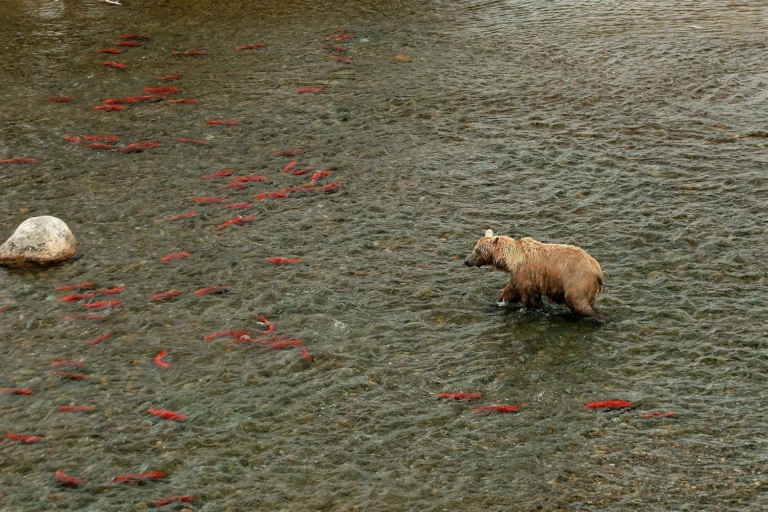
Wild salmon sustain a number of other species across the state of Alaska. Photo: Ken Morrish
But even here we are running up against limits. Fishing closures for kings—as we call prized Chinook salmon—are now routine.
Alaska, which has gone through a large population boom over the last eight years, is not immune to the insidious creep of civilization that destroys creeks, streams and wetlands—just like New England. Wild salmon need the land, the “habitat” to survive. And we are slowly carving up the forests and wetlands that salmon, and other fish and game, rely upon to renew their existence.
We must be more thoughtful about how we grow as a state, or we will lose the very resources that we most prize—the things that inspire a sense of pride and provide a livelihood for me and so many other Alaskans.
We have one last chance to get this right on the continent—to develop and mine our natural resources in a way that keeps food on the table and saves salmon, the very definition of a “renewable resource.” It’s up to us—you and me and every American—to walk into Alaska’s future with an eye to the past.
Fortunately, Alaskans in every corner of the state are showing real leadership. Earlier this year, nearly 42,000 citizens signed on to put a comprehensive fish habitat protection law before voters this November.
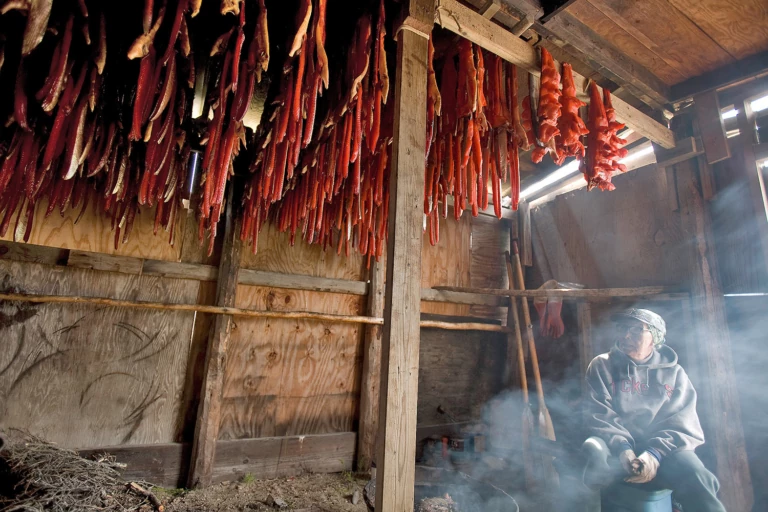
Robust wild salmon runs are a vital component to subsistence lifestyles in Alaska. Photo: Ben Knight
The initiative would bring Alaska’s fish habitat law, written in 1959, into the 21st century. It would establish science-based standards that force heavy industry to maintain clean water, fish passage and streamside buffers at mines and other project sites as they develop our resources. As it stands now, developers can wipe out streams in one watershed and make amends by setting streams aside for protection in some other watershed—potentially across the state. Our current law allows dam builders to replace a wild salmon run with a hatchery to offset massive hydropower projects such as the planned 735-foot Susitna-Watana on my home river. (That project is currently on hold, after a bunch of us—guides, school teachers, local business owners—rallied a broad group of Alaskans to speak out against it.)
This ballot initiative prevents development companies from making tradeoffs that benefit corporate coffers at the expense of local salmon and communities. The proposal gives the Alaska Department of Fish and Game more enforcement tools to ensure that growth doesn’t chip away at salmon runs—the death by a thousand cuts that has been the demise of so many Lower 48 wild fisheries. And for the first time, the public would be notified and invited to public comment periods on development projects in salmon habitat.
Everywhere I travel around this state, I’m seeing how invested Alaskans are in protecting salmon rivers. I was recently in the small interior community of Tanana and had the privilege of listening to a handful of Alaska Native fishermen on the Yukon River, which runs nearly 2,000 miles from the Yukon Territory across the belly of Alaska and into the Bering Sea. This river is one of the planet’s greatest demonstrations of migratory nourishment, with pulses of salmon delivering energy—nutritional and cultural—to hundreds of communities across the full length of that highway.
In the past decade, Yup’ik and Athabascan fishermen in Alaska have had to restrain themselves from taking king salmon. The populations of the largest and fattiest salmon dropped off so steeply that fishing communities agreed to leave whatever ran past them in the river, to allow spawning salmon to reach the farthest headwaters upstream.
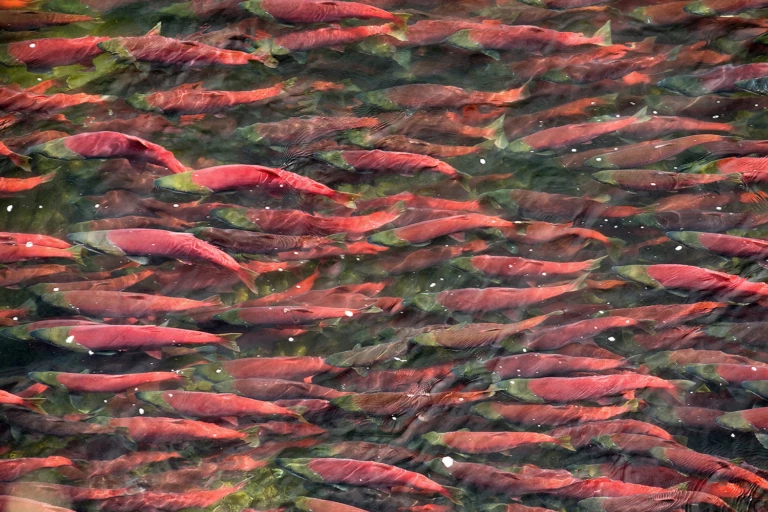
Schooling sockeye salmon in Alaska. Photo: Ben Knight
I heard from one resident, Charlie Wright, how that period of sacrifice also led to a spike in drinking and crime, not to mention hunger and increased poverty. “But for us there was no choice, really, when we took a hard look at ourselves in the mirror,” said Charlie. “If we lose them for good, we’re done.” Charlie represents the community of Tanana on the Yukon River Intertribal Fish Commission and is one of the habitat initiative’s leading proponents in the interior. “Protecting spawning streams and rearing habitat is one concrete thing we can do as Alaskans, as the climate changes and oceans warm up,” he continued. “It gives the fish—and everything they stand for—a fighting chance.”
The oil and mining industry has raised more than two million dollars to fight the initiative, which is still five months from a vote. The Pebble Limited Partnership—the group behind the Pebble Mine proposed for Bristol Bay, the world’s greatest sockeye fishery—has put in $200,000. But Alaska is still filled with thousands of people like Charlie, who are stepping up and speaking out.
There’s Jasmine Ieremia, 19, who travelled from Petersburg to speak to the Alaska Legislature this winter, saying “If the salmon went away, our town would dwindle.”
Gayla Hoseth is a chief of the Curyung Tribal Council and a defender of subsistence food traditions in Dillingham in southwest Alaska who has fought the Pebble Mine along with thousands of local people for more than a decade. For Gayla, this is about community health—access to food and a way of life that can’t be replaced at Costco.
Chris Tobias, a fly fishing guide in Wasilla, is teaching his kids to fish. “More than anything, I love seeing how jubilant my two young boys become when a wild salmon is brought to the boat,” he says.
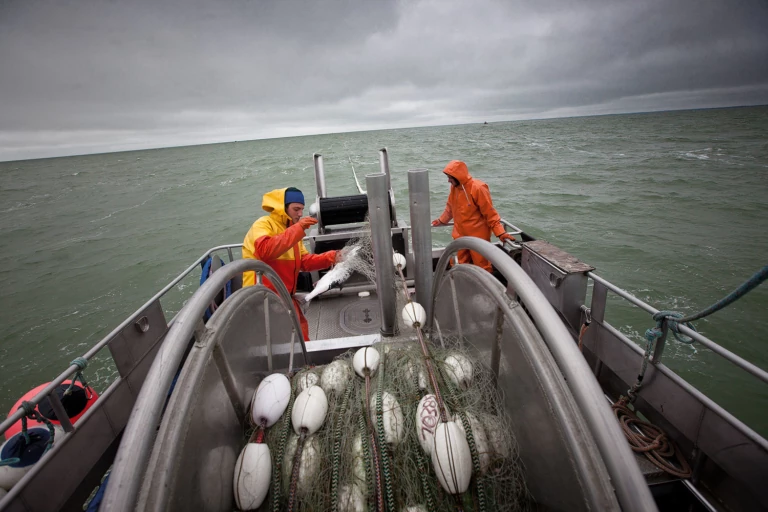
Commercial fishermen in Alaska. Photo: Bob Waldrop
Jay Hammond, Alaska’s fourth governor and a visionary who held office during the oil and gas boom and the construction of the Trans-Alaska pipeline, from 1974 to 1982, once said: “Alaskans should beware: some economic growth can be malignant. Unless development is environmentally sound, desired by most Alaskans and can pay its own way without burdening the state and tax payer, I’ll oppose it.”
For too long, we’ve all been paying for the development of this continent—in lost landscapes that once delivered wild food and clean water. That is a fool’s bargain, if you ask me. That is why changing the terms and passing this initiative feels hopeful. It’s something all Americans should care about.
Here is where you come in.
Whether you’re reading this in New England, the deep South, or the West Coast, you can make a difference right now for Alaska’s wild and pristine rivers. Alaskans stand poised to make history, by protecting our sustainable fishery, our jobs and our lives on the land for generations to come. The oil and mining industry is flying in from around the globe with big money and truth-bending ads, to persuade the world to continue the status quo. We need your help to win. Let’s use wisdom from the past to shape our future. Let’s Stand for Salmon.
Stand for Salmon
You can take a stand for Alaska’s wild salmon by signing up for campaign updates and making a donation in support of better habitat protection across this amazing state.
